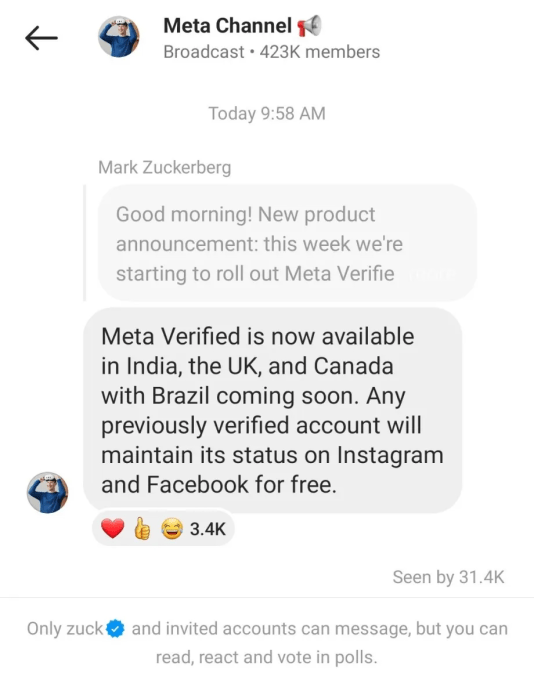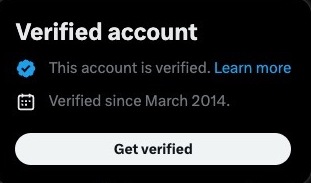Meta Verified, the Facebook and Instagram owner’s recently launched paid verification system, is expanding to India, the company announced today via post from CEO Mark Zuckerberg on his Instagram Broadcasts channel. In addition to its recent expansion to the U.K. and elsewhere, after first arriving in the U.S., Australia, and New Zealand earlier this year, the company says paid verification is available to all users in India, with Brazil coming soon.
Zuckerberg’s message included Canada and the U.K. as “now available” markets, but the feature was actually spotted rolling out in the U.K. last month. In addition, Meta announced it would begin testing the service in Canada just last week. That means India is the only true new addition here, which a spokesperson for Meta confirmed.
“We are expanding the test to India starting today and will roll out on Instagram and Facebook to everyone eligible there over the next couple weeks,” the spokesperson told TechCrunch.
Users had reported seeing the Meta Verified waitlist open up back in India back in March, but it was not made available to all at that time.

Image Credits: Meta
Meta says the subscription in India is available for direct purchase on Instagram or Facebook starting today. People can purchase a monthly subscription for ₹699 on iOS and Android. In the months ahead, it will also introduce a web purchase option for ₹599 a month.
The other news Zuckerberg shared today is that Meta will continue to honor “legacy blue badge” for those who were verified before the launch of Meta Verified based on existing criteria. This a differentiator from how Twitter had approached its own verification system — yanking the legacy badges away from users in the hopes that they would convert to paid subscribers. The move didn’t apparently work, as Twitter quietly updated the badges’ text to now show when a user had first become verified. )Those with older verification dates, naturally, would signal having been legacy verified.)

Image Credits: Twitter screenshot, Verified badge text as of this week
Meta explains its thinking in today’s announcement, saying:
These accounts passed through a set of criteria to confirm their authentic presence and may be more susceptible to impersonation than the average user. So, it’s important we maintain the verified badge to protect their accounts and the people that engage with them.
Meta’s subscription service is arguably a more well-thought-out version of Twitter’s own attempt to monetize its own power users with the launch of its Twitter Blue subscription, which preceded Meta Verified. As of March, Twitter Blue had made just $11 million on mobile during its first three months on the market. The service had also faced a number of challenges as well, as users were adopting paid badges to engage in impersonation, not be protected from it.
Meta Verified, on the other hand, includes a range of additional benefits beyond the coveted checkmark. After providing a government ID to confirm your identity, subscribers gain access to “proactive” impersonation protection and direct access to customer support, in addition to other benefits like a badge and exclusive stickers on Facebook and Instagram Stories and Facebook Reels, plus 100 Stars per month on Facebook to support other creators. Applicants must be at least 18 years old to sign up for Meta Verified.
In today’s announcement, Meta notes that it has tweaked its subscription offering since its first launch, including the removal of increased reach for additional test countries, as one of its perks. This “continues to be the approach for India,” the company noted.
Generally, Meta Verified pricing is consistent with its base pricing in the U.S. of $11.99 per month on the web and $14.99 per month on mobile. In the U.K., the subscription pricing was set at £9.99 per month each for Instagram and Facebook.
Meta Verified arrives in India, now honors ‘legacy’ verified badges by Sarah Perez originally published on TechCrunch















 English (US) ·
English (US) ·